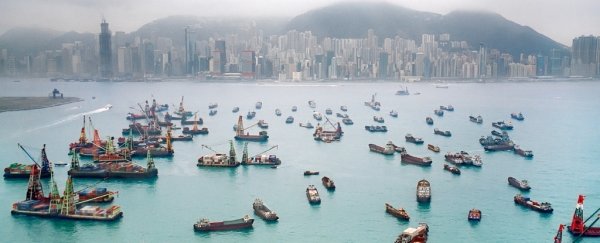The physical footprints left behind by humankind don't wash away with the waves.
Human construction has modified the oceans as much as it has urbanised the land, a new analysis reveals.
Mapping the global extent of human development in Earth's oceans, an international team calculated the footprint occupied by human built structures as of 2018, including anything from tunnels to bridges, wind farms to aquaculture. The result comes in at roughly 30,000 square kilometres, covering 0.008 percent of the ocean.
However, in another sense, it's much more extensive than that. Even after we put our initial stamp on a marine ecosystem, the impacts of our actions can bleed out, changing water flow and spreading pollution, among other sorts of effects.
If we take into account such modifications to the seascape around these structures, the overall oceanic footprint ends up being more like 5 percent, covering 2 million square kilometres – an area greater than that covered by all of our world's mangroves and seagrass beds.
Our world's coasts add up to hundreds of thousands of kilometres of shoreline, and most marine construction is located within 200 nautical miles of the shore, in what is known as the exclusive economic zones (EEZs).
This is where nations can legally explore and use marine resources, and similar to urbanisation, which covers up to 1.7 percent of land, the new study found marine construction makes up about 1.5 percent of EEZs.
"The numbers are alarming," says marine biologist and ecologist Ana Bugnot from the University of New South Wales.
In less than a decade, if nothing changes, the extent of seascapes we humans will have modified is astounding. The team's projections, which they describe as 'conservative', show marine infrastructure for power and aquaculture is on track to increase 50 to 70 percent by 2028.
"Marine development mostly occurs in coastal areas," adds Bugnot, "the most biodiverse and biologically productive ocean environments."
Nevertheless, research on these ecosystems is extremely hard to come by. In fact, 86 percent of EEZs are missing data. And yet 99 percent of marine construction occurs in these zones.
What's more, most public lists of marine construction are based on information from private companies and individuals with little oversight.
As a result, Bugnot thinks her team's projections for the future probably underestimate our true ocean footprint.
"There is a dearth of information on ocean development, due to poor regulation of this in many parts of the world," she says.
And there's a lot of money to be had. Global aquaculture is a multi billion dollar industry that makes up nearly half the ocean food we humans currently consume.
China's EEZ alone was found to contribute 40 percent of all global ocean construction, and this huge chunk was mainly driven by aquaculture farms.
At the same time, more and more companies are competing in a 'gold rush' on the deep sea floor for precious minerals, and energy production on the coast, including wind farms as well as gas and oil rigs, continues to expand.
Wave, tidal, and wind farms are, of course, nowhere near as bad for the environment as fossil fuels; however, these structures are expected to grow really fast in the coming years, and if we're not careful, this could impact local ecosystems for the worst.
Tidal farms alone, which use stream generators to produce energy, are expanding at over 200 percent yearly, the authors found, and unlike wind farms, these structures can impact more than just their local region.
"Particularly for tidal farms," the authors say, "their expansion is likely to replace large areas of natural habitats due to their sheer size."
More research is needed on how renewable energy solutions may impact coastal ecosystems, on a local and global scale. While we might be able to limit our impact somewhat, the authors caution against 'greenwashing' these greener structures, "which will always impact natural habitats" to some extent.
"For example, while artificial reefs have been used as 'sacrificial habitat' to drive tourism and deter fishing, this infrastructure can also impact sensitive natural habitats like seagrasses, mudflats and saltmarshes, consequently affecting water quality," explains Bugnot.
Without these natural barriers on our coasts, we leave ourselves vulnerable to the whims of the sea. As rising tides and ever more violent storms threaten coastal cities, governments are building their own defensive structures against waves, storm surge, and erosion.
Over half the natural shorelines in the United States have already been replaced by seawalls, breakwaters, and other permanent structures.
And then there are the hotspots where all our marine construction collides.
In 10 percent of the coastal areas studied, the authors noted multiple human structures at play, including wind farms, breakwaters, tunnels, bridges, and commercial ports.
Of all these forms, the authors found shipping noise created the most extensive threat by far, modifying marine ecosystems over 10 kilometres away from a port or marina.
"Commercial ports, therefore, contributed to [over] 99 percent of seascape modification," the authors conclude, "due to their extensive physical footprint, combined with widespread noise pollution at distances of [roughly 20 kilometres] per port."
By 2030, the authors expect commercial port capacity to double.
More resources and services are needed for a burgeoning global population, but the team warns that if national and international bodies don't take marine conservation into their current construction plans, we could lose even more of our precious coastal ecosystems and the biodiversity they hold.
The study was published in Nature Sustainability.
